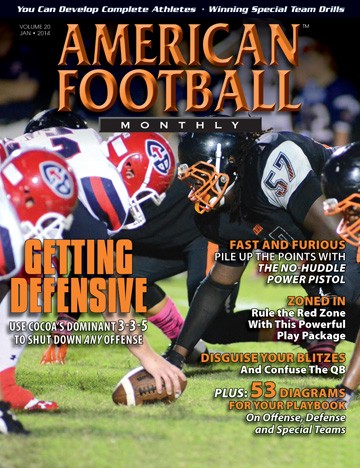Speed Report: Is Your Speed Training the Real Deal?
by: Dale BaskettFootball Speed Specialist©
More from this issue
Have you analyzed why you use the methods and teaching applications for football speed training? Have you just borrowed available concepts and plugged them into your program? Are you just covering bases or do you really feel you’ve reached a high level of knowledge and are satisfied with your results?
Where did you get what you use today and is it working? Why did you choose to incorporate it into your program? Did you get your material from a friend, a colleague, a relative, or your old coach from high school because he won a lot of games? Or, did it come from the internet, which has offered the same drills for the last 30 years but just with different wrapping paper – the A drill, B drill, ladder drills, and wall drills. The list goes on and on.
Is your knowledge in speed development solid? If so, why? You’ve put together a package but is it the real deal? Most football coaches are not football speed experts and they know it. Nothing is wrong with that. On the other hand, it would serve you well to consider that what you’re using might be inferior to what it could be. Football is a complex sport to coach, especially if you’re a head coach. It takes an enormous amount of hours and dedication and sacrifice by the entire coaching staff to be successful. The same is true for speed and movement. The measure of success depends on specific methods and techniques. Unfortunately, track sprint workouts and the drills used are not grooming motor habits for required football movements. Anytime you displace momentum or direction, mechanical function takes a hit immediately. Lineal speed work has its place. However, high-intensity multi-movement transition speed challenges technical control. The difference is what drill techniques you use.
Better Methods - the Real Deal
Correct measures of training and development theories are available for those who want to maximize real systematic training. That is, non-specific applications. Take a look at the latest and most specific football speed package ever assembled.
Weight training, which began before speed training, started in the 1970’s by a track athlete who began an experiment with the head coach of Nebraska. The experiment was to lift weights as a team for one off-season. It worked. The first weight training for football was successful and weight training is what it is today because of it. Weight training has grown and the technical changes over time are almost too hard to comprehend. Still, new applications continue to come along.
Speed techniques have not changed during that time. Mechanical theory for football demands are the same. The “real deal” is having a system for processing variable football movements while changing acceleration patterns. Having the correct technique is the only way to process effective and rapid speed transitions. This is the key to football speed and movement. It is not equipment or the same 30-year old drills still being used today.
Yet, 35-plus years have come and gone and there’s no where to go to find the “real deal.” High school, college and professional teams still use the same running and movement drills to produce faster athletes. I’m 34 years deep in the craft and was the first speed coach in America beginning in 1979. Over time, I have developed a technical specificity system.
Here is a listing of tips and insights that will help you head in a positive direction:
• Never train for speed without first having a solid foundation.
• Speed is developed by first having an organized and progressive training series that builds the player systematically.
• Nothing is going to work if you don’t start by getting the technical foundations solid at slower speeds.
• Mechanical functions are always the main concern for training.
• Recovery with a 1 to 5 ratio will provide capability for control. Remember, every move is being recorded and must be consistent and correct.
• 30 - 40 minutes is ample time for training. Staying fresh is critical for processing the right methods desired.
• Mental focus during the sessions is mandatory if your athletes are to gain kinetic comprehension. That is, feeling the activity to keep everything in place.
• Running is a cyclic limb activity and is a non-stop rotational continuance which is why conscious control is a major factor at each session.
• Teach the players to hear the verbal commands you give and draw word pictures from them.
• Variety in a system is always good for learning to shift focus so the players learn to think and visualize the tasks presented.
Coach Baskett began his career as a football speed coach in 1979. During the last 34 years he’s consulted and trained hundreds of coaches and thousands of athletes nationwide. In the last year he has worked directly with high schools in California, Texas, Minnesota, Kansas, and Pennsylvania. Over the last few years he has also consulted with Texas Tech, Ohio State, USC, University of Washington, and the University of Mount Union. You can reach him directly for more information or if you have specific questions on your training program. Coach Baskett is at dbspeedt@hotmail.com and 858-568-3751.





